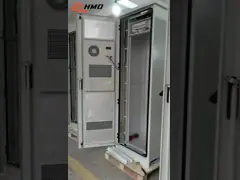Product Details
PLC Control Cabinet for Automotive Manufacturing Welding Robots
Product Describe:
- Controlling mechanical equipment such as robotic arms, conveyor
belts, welding machines, and painting systems to ensure precise
execution of assembly steps (e.g., welding seams, part positioning,
and paint spraying sequences).
- Collecting real-time data from sensors (e.g., pressure,
temperature, and position sensors) to monitor equipment status and
production parameters, enabling timely adjustments if deviations
occur.
- Coordinating the operation of multiple production stations (e.g.,
stamping, welding, painting, and final assembly) to achieve smooth
workflow and synchronization.
- Supporting integration with upper-level systems like MES
(Manufacturing Execution System) for data exchange, facilitating
production scheduling, quality tracking, and fault diagnosis.
Specification:
| Type | Dimensions (Height × Width × Depth, unit: mm) | Notes |
| Standard Sizes | Small (single robot/station): 800×600×300 – 1200×800×500 | Compact sizes for standalone welding robots or simple assembly
stations; larger enclosures for integrating multiple PLC modules,
HMI screens, and communication devices. |
| Medium (multi-robot coordination): 1500×1000×600 – 1800×1200×800 |
| Large (line-level control): 2000×1500×800 – 2200×1800×1000 |
| Custom Sizes | Flexible based on: | Can be tailored to non-standard dimensions (e.g., low-profile
600×400×200mm for limited spaces) or reinforced structures for
heavy-duty components. |
| - Number of connected devices (robots, sensors, actuators) |
| - Installation space (floor-mounted, wall-mounted, or embedded in
production lines) |
| - Special requirements (e.g., explosion-proof enclosures for paint
shop zones) |
Material:
Aluminum alloy, stainless steel, carbon steel
Suggestion:
1. Size & Layout: Match dimensions to robot count and installation
space. Optimize internal layout for easy wiring/maintenance, with separate
zones for power and control components.
2. Durability: Use rugged enclosures (IP65+) for factory floors; opt for heat-resistant materials near welding stations.
3. Compatibility: Ensure integration with robot protocols (e.g.,
Profinet, Ethernet/IP) and add ports for future sensors/AGVs.
4. Safety: Include emergency stop relays and surge protection. For welding areas, add shielding against electrical interference.
5. Monitoring: Integrate a compact HMI for real-time status checks
and quick parameter adjustments.
Company Profile
HMD is a specialist in the research, development, and manufacturing
of industrial automation control systems, with a strong focus on
custom-built low-voltage control panels and PLC intelligent control
cabinets.
We have established strategic partnerships with leading component
manufacturers such as Siemens, Schneider, and ABB, ensuring that
every solution we deliver is built on reliable, high-performance
components. Committed to providing end-to-end electrical cabinet solutions, we
tailor-make cabinets with functionalities precisely aligned to your
unique requirements—from design to delivery, we handle it all.
Backed by a team of seasoned electricians, CAD/EPLAN-certified
designers, and expert PLC programmers, we adhere strictly to
rigorous quality management systems. This enables us to offer comprehensive one-stop services,
encompassing solution design, precision machining, and system
commissioning. Our products find wide application across smart buildings,
industrial automation, energy management, and beyond, empowering
seamless and efficient operations in diverse sectors.



